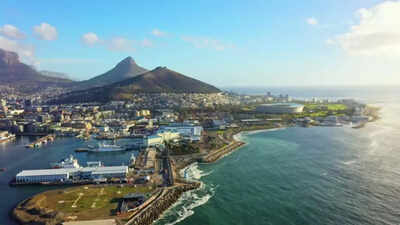ARTICLE AD BOX

A new study has revealed that the land in South Africa is rising, and the reason may be more alarming than previously thought. Between 2012 and 2020, researchers recorded an average uplift of 6 millimetres, or nearly 2 millimetres each year. While it was earlier believed that geological activity or mantle flow was causing this change, recent findings suggest that drought and water loss might be the real culprits. As water levels drop, the Earth’s crust experiences an upward rebound, hinting at a deep and complex relationship between climate change, water management, and urban development.
No tectonic plates but vanishing water is causing upliftment
Previously, scientists assumed that rising land in South Africa was due to seismic or volcanic activity, especially from the Quathlamba hotspot. However, researchers from the University of Bonn have now linked the vertical land movement to the loss of surface and subsurface water. During droughts, as groundwater, soil moisture, and surface water disappear, the weight pressing down on the crust reduces. This results in the land bouncing back, a phenomenon called elastic rebound, observed through advanced satellite and ground-based measurements.
How Cape Town’s drought revealed the trend
Cape Town’s infamous Day Zero crisis, which began in 2015, was a key case for studying this phenomenon. The research team initially set out to investigate water loss during the city’s extreme drought between 2015 and 2018. Using data from South Africa’s GNSS-Trignet base stations, which track vertical land motion, scientists confirmed that land uplift closely followed periods of reduced water mass. This showed that water scarcity has a visible, measurable effect on the very shape of the Earth’s surface.
Scientists track the uplift through satellite and GPS
To understand the uplift pattern across South Africa, scientists analysed GPS data from 2000 to 2021. They used geophysical models to convert vertical land movement into estimates of water loss. These were cross-checked with satellite gravity data from GRACE and other hydrological models. The findings confirmed a consistent correlation between water loss and land rise across multiple regions, not just Cape Town. This made it clear that the pattern is national, not local.
The science behind land rising and sinking
While drought-related uplift is becoming more common, it contrasts sharply with land subsidence caused by groundwater over-extraction in other parts of the world. Researcher Christian Mielke explained that two processes are at play. The loading effect causes uplift when surface water mass is lost and the crust rebounds. On the other hand, the poro-elastic effect causes land to sink when aquifers dry up and collapse. Which effect dominates depends on the local geology and the type of water loss.
South Africa’s water use under scrutiny
The study also revealed that South Africa’s water consumption is far higher than the global average. South Africans use around 237 litres of water per person per day, compared to the global average of 173 litres. Gauteng and the Western Cape, which include major cities like Johannesburg and Cape Town, are among the highest consumers. With increasing droughts, this level of usage is unsustainable and contributes to the complex challenges of land deformation and water stress.
Rising inequality in water access
The water crisis is not equally shared. A Cape Town survey showed that the wealthiest 13.7 percent of residents consumed more than half of the city’s total water. Elite households used up to 2,161 litres daily, while lower-income families used just 178 litres. Informal settlement dwellers survived on as little as 41 litres per day. This imbalance worsens the impact of water shortages and puts additional strain on urban infrastructure and the environment.
A warning sign for urban development
The study is a reminder that urbanisation without planning can have invisible, long-term consequences. As soil moisture declines and concrete replaces natural recharge zones, the Earth’s crust is affected in ways not immediately visible. These shifts influence groundwater storage, increase vulnerability to future droughts, and alter land stability. Urban design must now consider the broader impacts of water loss, not just for environmental sustainability but also for infrastructure resilience.
A call to rethink water management
Cape Town and other South African cities need to urgently revise their water strategies. Measures such as reducing waste, recycling treated wastewater, and enhancing rainwater harvesting are critical. Long-term planning must address both climate resilience and social equity. As climate change deepens the gap between supply and demand, cities must act now to protect both people and the planet. The rising land is not just a geological anomaly—it is a warning from nature to change course.



.png)
.png)
.png)
















 5 days ago
9
5 days ago
9









 English (US) ·
English (US) ·